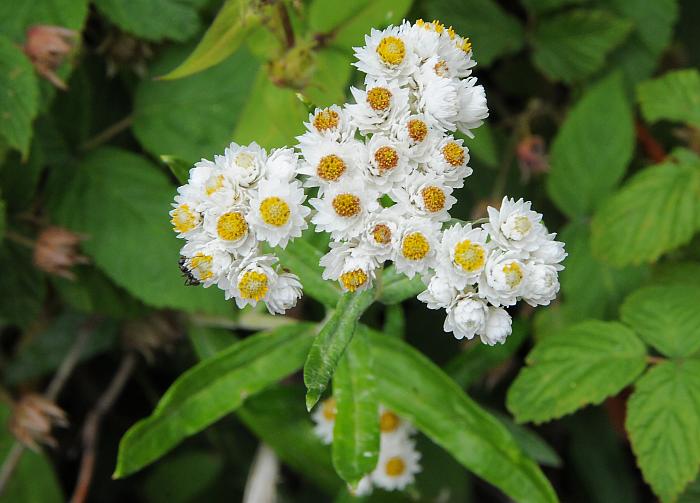Anaphalis margaritacea (L.) Benth. & Hook. f.
Pearly Everlasting

Introduced
CC = *
CW = 5
MOC = 2
© SRTurner
Anaphalis margaritacea (L.) Benth. & Hook. f.Pearly Everlasting | |
 |
Introduced CC = * CW = 5 MOC = 2 |
© SRTurner |
|
Family - Asteraceae/Gnaphalieae Habit - Rhizomatous perennial forb, incompletely dioecious. Stems - Erect, to 80 cm, densely wooly.
Leaves - Basal leaves usually absent at flowering, not noticeably larger than the lower stem leaves. Stem leaves numerous, sessile, 2-12 cm long, linear to elliptic-lanceolate, bluntly to sharply pointed at the tip, sometimes slightly expanded and clasping at the base, the margins entire and sometimes curled under, both surfaces densely white-woolly, the upper surface sometimes becoming nearly glabrous with age.
Inflorescence - Inflorescences rounded to more or less flat-topped, often relatively dense panicles, the individual heads mostly short-stalked.
Heads - Heads all staminate or mostly pistillate, the pistillate heads usually with 2-4 staminate central florets. Involucre 5-8 mm long, broadly ovoid to cup-shaped, the bracts in 7-12 overlapping series, mostly loosely appressed when young, spreading with age, mostly bluntly pointed at the tip, woolly at the base, bright white, showy, usually slightly shiny. Receptacle nearly flat, naked. Ray florets - Absent. Disk florets - Corollas 3.5-4.5 mm long, yellow to greenish yellow. Pappus of numerous capillary bristles, these free and shed individually, minutely toothed.
Fruits - Achenes 0.7-1.0 mm long, narrowly ellipsoid-obovoid, strongly flattened, the surface appearing pebbled or roughened with minute papillae, brown to olive brown. Flowering - July - September. Habitat - Cultivated. Origin - Native to the U.S. but probably not Missouri. Lookalikes - None. Other info. - This distinctive and showy species is very common in western and northeastern regions of the U.S., but is rare in most of the Midwest and Plains states. It Missouri it has been collected only twice, and not since 1958. These were probably remnants from cultivation, since the plant is a popular ornamental. This is an easy species to identify. The distinctive papery-white involucre bracts are the showiest parts of the plant. Photographs taken in Marquette, MI., 9-3-03 (DETenaglia); also roadsides in Linn County, OR, 8-28-2012, and Teton County, WY, 8-30-2012; and in Larimer County, CO, 7-29-2017 (SRTurner). |